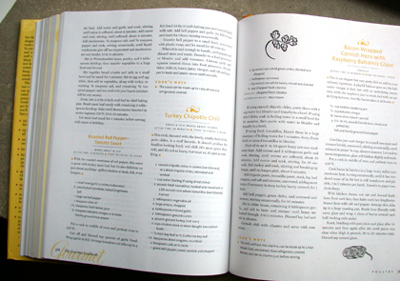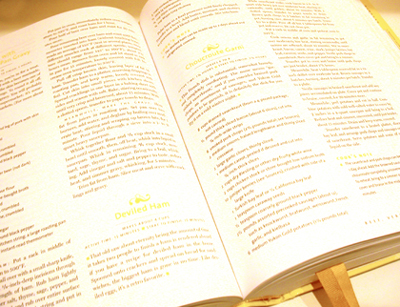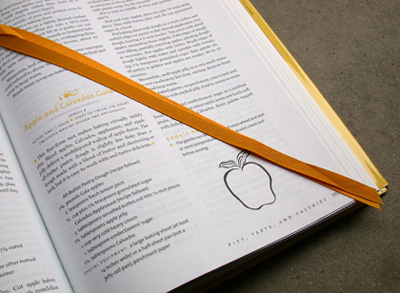I had lunch yesterday with Beth Tondreau; and as it usually happens when meeting a designer at their studio, I found myself waiting for her to get that one last file out. In this case, it was a PDF file of a cookbook cover.
Making small talk, I asked her if she was familiar with The Gourmet Cookbook; to which she instantly replied, “The yellow?”
Yes. That notorious yellow.

For six glorious decades Gourmet magazine has been a major element in the definition of American cuisine — featuring notable food writers like James Beard and M.F.K. Fisher. To celebrate their 60th anniversary, the editorial team — lead by patron saint Ruth Reichl — whittled down an enormous library of 50,000 recipes to 1200 and published The Gourmet Cookbook.
This was a huge project. Gourmet staffers spent three years refining their selections, and publisher Houghton Mifflin reportedly paid a million-dollar advance with a promise of another million in publicity. For the first edition a quarter million copies were printed in time for the Christmas 2004 shopping season.
Well… every design project has a tragic flaw, and in this case it is the color of the highlight typography: pale yellow. In daylight or strong, direct light, it’s readable. A bit pale, but still readable.

Under a yellowish, incandescent light, the names of the recipes disappear.

Almost instantly, reader reviews on Barnes and Noble and Amazon were complaining about the unreadable color. In the Washington Post, Reichl said it was a “horrible surprise” and claimed it was a printing mistake.
One can easily see how such an error can appear, considering the state of the standard American design workflow. Colors which are selected on bright white Pantone stock, have body and saturation on computer screens (most-likely uncalibrated), and are proofed on ink-jet printers filled with opaque fluorescent ink. Meanwhile in the real world of presses and paper, inks are transparent — a condition further aggravated by dryback — and, unless specified, not fluorescent. The press proofs were probably viewed in a proper 5000-degree Kelvin MacBeth environment instead of a typical incandescent-lit kitchen.
Given the significance of the color problem, I also wonder whether ink drawdowns or press proofs were submitted during the production stage. Our studio recently completed an exhibition catalog for an art gallery. The printer printed every spread from the whole book — on a press — with ink — instead of making “soft proofs” on an Epson. That set of press proofs then became the quality-control when the forms were printed. The Gourmet Cookbook was printed in the USA. My printer was in China, which is significantly less expensive; thus we could afford to do the press proofs.
The Gourmet yellow serves as an object lesson for designers at any level of experience. It is so easy to get caught up in the weightless world of the computer. Mental constructs become “real” in an instant, and the crispness of what is on the screen can easily erase all doubt about the final product.
I appreciate the logic behind choosing yellow. It is the color of two basic ingredients in cooking: butter and eggs. Except, in this case, it probably would have been better to go with the color of Italian egg yolks rather than American ones.

The editors at Gourmet promise to change the color in the second edition. This has the potential to create an instant collector’s item — the invisible cookbook. In the spirit of the rare stamp known as the Inverted Jenny, I propose the first edition be called the Yellow Ruth.
Who knows… if you keep your copy clean, it may be worth something someday.

Finally, since the Gourmet staff is makng changes, I would like to humbly suggest two others. First, improve the index. It is not as comprehensive as it should be. Second, please add a half inch to the place-marker ribbons. The current length is too short, making it difficult to slide past the diagonal corner. (See above)






The culinary world saw red. But I can vouch for the fact that whatever the color, this was no yellow peril. My wife got no less than four copies for Christmas. Four. While difficult to navigate the titles and subtitles, the Gourmet cookbook still has the best recipes. Yellow is not the best color to have selected, but its not the wurst (sorry). At least it wasn't blue. Now that would have been nauseating.
On Jan.20.2005 at 05:20 AM